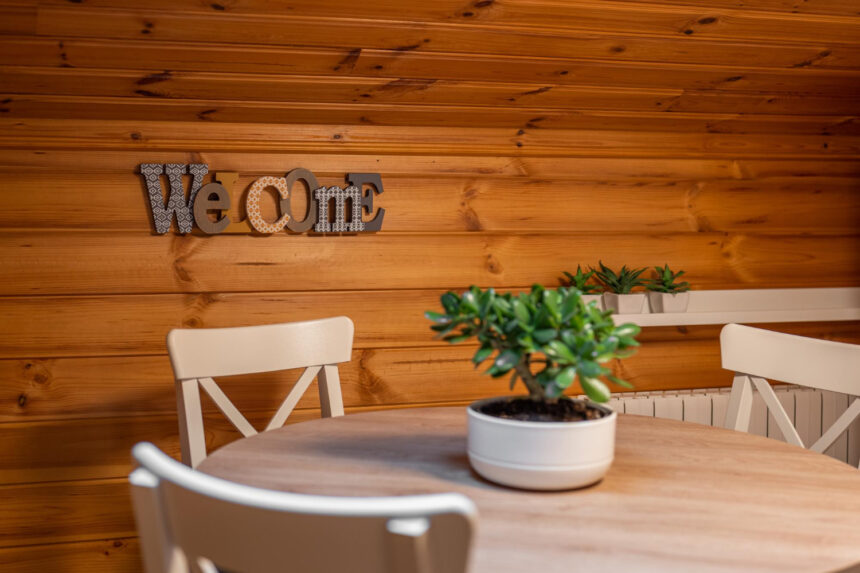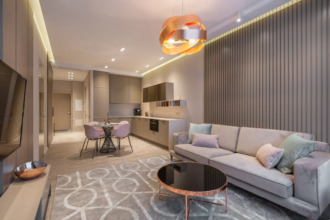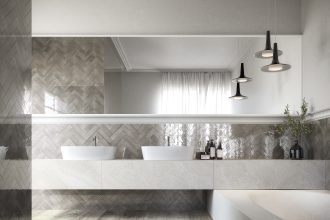Walk into a restaurant where oak tables gleam under soft lighting, walnut chairs invite lingering conversations, and cedar accents perfume the air with subtle fragrance. These wooden elements aren’t just decorative choices—they’re fundamental components that shape how we experience dining spaces. Restaurants that incorporate natural materials in their design create environments that connect with guests on visceral, often subconscious levels.
Kyivworkshop craftsmen have witnessed countless restaurant transformations through thoughtfully integrated wooden elements. From hand-carved host stands to custom booth seating, we’ve observed how wooden features become central to a restaurant’s identity and success. But what specific qualities make wood so valuable in restaurant environments? Let’s examine the concrete benefits behind this enduring design choice.
The Psychology Behind Wooden Spaces
When guests enter spaces featuring wooden restaurant décor, something measurable happens. Research shows that visible wood in interior spaces can lower blood pressure, decrease stress response, and improve concentration—physiological benefits that directly enhance dining experiences.
Designer Elena Kowalski puts it plainly: “Wood communicates honesty. In restaurants, where perceived value matters tremendously, natural materials signal authenticity that guests interpret as quality.”
This psychological comfort works across demographics and dining styles. The organic variations found in wood grain provide visual complexity that our brains find simultaneously engaging and soothing—stimulating enough to feel special but natural enough to induce relaxation. This paradoxical combination makes wooden environments particularly suited for restaurants, where both memorability and comfort drive success.
Wooden Chameleons: Adaptability Across Concepts
Timber restaurant design spans virtually every restaurant category—from quick-service establishments to Michelin-starred destinations. This remarkable adaptability stems from wood’s diversity:
- Fine Dining: Quarter-sawn oak with tight grains conveys precision and refinement
- Neighborhood Bistros: Mixed reclaimed woods with visible history create instant nostalgia
- Modern Eateries: Sleek maple or ash installations with minimalist detailing suggest contemporary confidence
- Themed Restaurants: Woods native to specific cuisines (Mediterranean olive wood, Japanese hinoki) reinforce cultural authenticity
A restaurant owner can direct a craftsman to create wildly different atmospheres using the same basic material. Few other design elements offer this level of control while maintaining cohesive quality throughout a space.
Beyond Trend: Wood as Smart Business
Environmental consciousness now drives consumer choices across industries. This shift makes sustainable restaurant design financially savvy rather than merely virtuous. Properly sourced wooden elements provide legitimate environmental credentials:
- Trees absorb carbon throughout their growth, which remains stored in the wood
- Local sourcing reduces transportation emissions
- Quality wooden furnishings typically outlast synthetic alternatives by decades
- Worn wooden elements can be refinished rather than discarded
- End-of-life wooden components biodegrade naturally or become raw material for new products
Many successful restaurants now incorporate wood sourcing stories into their brand narratives. A bar top made from a historic local building or tables crafted from neighborhood trees create talking points that engage guests while differentiating the establishment from competitors.
Environmental consultant Teresa Lang notes, “Restaurants featuring legitimate sustainability stories perform measurably better in consumer perception studies. Wooden elements provide visible proof of those environmental commitments.”
Hard Numbers: The Practical Case for Wood
Restaurant ownership demands pragmatic decisions. Fortunately, wooden furniture for restaurants offers concrete operational benefits beyond aesthetics:
Lifespan Economics
Quality wooden furnishings typically cost more initially but deliver superior long-term economics:
- A well-made hardwood table might cost 30-40% more than a laminate alternative but last 5-8 times longer
- Wooden chairs can be reglued and refinished multiple times, extending their service life dramatically
- Wooden bars and countertops can be sanded and refinished in place, avoiding replacement costs
- The patina that develops on wooden surfaces often increases perceived value over time, unlike synthetic materials that simply look worn.
Restaurant accountant Michael Rodriguez calculates that premium wooden furnishings typically reach cost-parity with cheaper alternatives within 4-6 years, then deliver substantial savings thereafter.
Sound Management
Excessive noise ranks among diners’ top complaints in modern restaurants. Wooden design elements help manage this problem:
- Varied wooden surfaces break up sound waves, reducing harsh echoes
- Wooden ceiling treatments absorb specific frequency ranges that interfere with conversation
- The porous nature of wood absorbs sound rather than reflecting it like stone, metal, or glass
These acoustic properties allow restaurants to maintain an energetic ambiance without creating the conversation-killing din that drives customers away.
Standing Out: Distinctive Wooden Identity
Manhattan restaurant consultant Jenna Park tracks design elements that generate social media engagement. “Distinctive wooden features consistently drive photography and shares,” she reports. “A custom wooden element with character becomes a visual shorthand for the entire restaurant experience.”
The rustic restaurant interior trend exemplifies this phenomenon, with distinctive wooden elements frequently becoming visual signatures:
- Hand-carved wooden menu boards that change seasonally
- Dramatic communal tables crafted from single tree slabs
- Custom wooden light fixtures that cast distinctive shadow patterns
- Bar tops featuring embedded objects or storytelling elements
These wooden focal points give guests specific visual hooks for memory and sharing, which are critical factors in building restaurant recognition.
Material Harmony: Wood in Context
Effective restaurant design rarely relies on wood exclusively. Instead, thoughtful designers use wood strategically within material compositions:
- Wood paired with polished concrete creates approachable industrial vibes
- Wood combined with brass or copper elements introduces warmth to sleek spaces
- Wood, alongside soft textiles, enhances acoustic properties while adding tactile contrast
- Wood juxtaposed with large glass elements balances heritage and modernity
These material conversations prevent the heaviness that can result from wood-only environments while maximizing wood’s unique properties.
Beyond Trendy: The Staying Power of Wood
Restaurant industry veterans know that following design trends too closely often leads to spaces that quickly feel dated. Wood offers a solution to this dilemma—it carries enough historical precedent to avoid seeming trendy, yet remains perpetually relevant.
Designer Marco Williams explains: “The restaurants I designed twenty years ago with quality wooden elements still look appropriate today. The same can’t be said for spaces that leaned heavily into the design trends of the moment.”
This timelessness provides practical longevity for restaurant spaces, which typically face renovation pressures every 7-10 years. Quality wooden elements often survive multiple concept refreshes, offering continuity while other design elements evolve.
Wood as an Investment, Not Expense
Restaurant developers increasingly view wooden elements as capital investments rather than design expenses. This shift recognizes that quality wood features:
- Appreciate aesthetically over time as patina develops
- Frequently outlast the restaurant concept itself, carrying forward to new iterations
- Often become part of a restaurant’s marketable identity
- Provide legitimate sustainability credentials that influence consumer choice
- Create measurable impacts on diner psychology and behavior
This investment perspective helps justify premium materials and craftsmanship, particularly for restaurant groups planning for long-term operation.
Real Returns: Measurable Benefits of Wood
Researcher Alison Chen studied 150 restaurants across multiple markets and found that establishments featuring significant wooden elements showed:
- 24 minutes longer average guest stay compared to synthetic-dominant environments
- 23% higher likelihood of alcohol orders
- 18% higher average dessert sales
- Substantially higher Yelp review scores specifically mentioning atmosphere
These metrics translate directly to revenue, making wooden design elements business tools rather than mere aesthetic choices.
Creating Character Through Craft
Mass-produced wooden elements provide some benefits, but custom-crafted ones introduce a distinctive character. Restaurant owners increasingly work directly with woodcraftspeople to create signature elements that tell specific stories:
- Tables built from trees harvested from a property’s grounds
- Bar tops incorporating wood from buildings significant to local history
- Booth seating featuring carving techniques traditional to a restaurant’s cuisine
- Wooden service pieces explicitly designed for signature menu items
These collaborative creations forge connections between restaurants and their communities while providing noteworthy details that distinguish establishments from their competitors.
Wood as an Essential Restaurant Element
Kyivworkshop has created wooden components for hundreds of restaurants across diverse concepts, price points, and markets. This experience confirms what research demonstrates: thoughtfully incorporated wooden elements provide measurable benefits beyond aesthetic appeal.
From psychological comfort to acoustic management, from sustainability credentials to long-term economics, wood offers restaurant owners concrete advantages that directly impact business success. While design trends come and go, wood remains a foundational material that connects with diners across demographics and dining styles.
For restaurant owners planning new concepts or renovations, investing in quality wooden elements represents a sound business strategy. Wood creates spaces where guests intuitively want to linger, return, and share their experiences. In a competitive industry where small advantages matter tremendously, wood delivers tangible benefits that few other materials can match.















